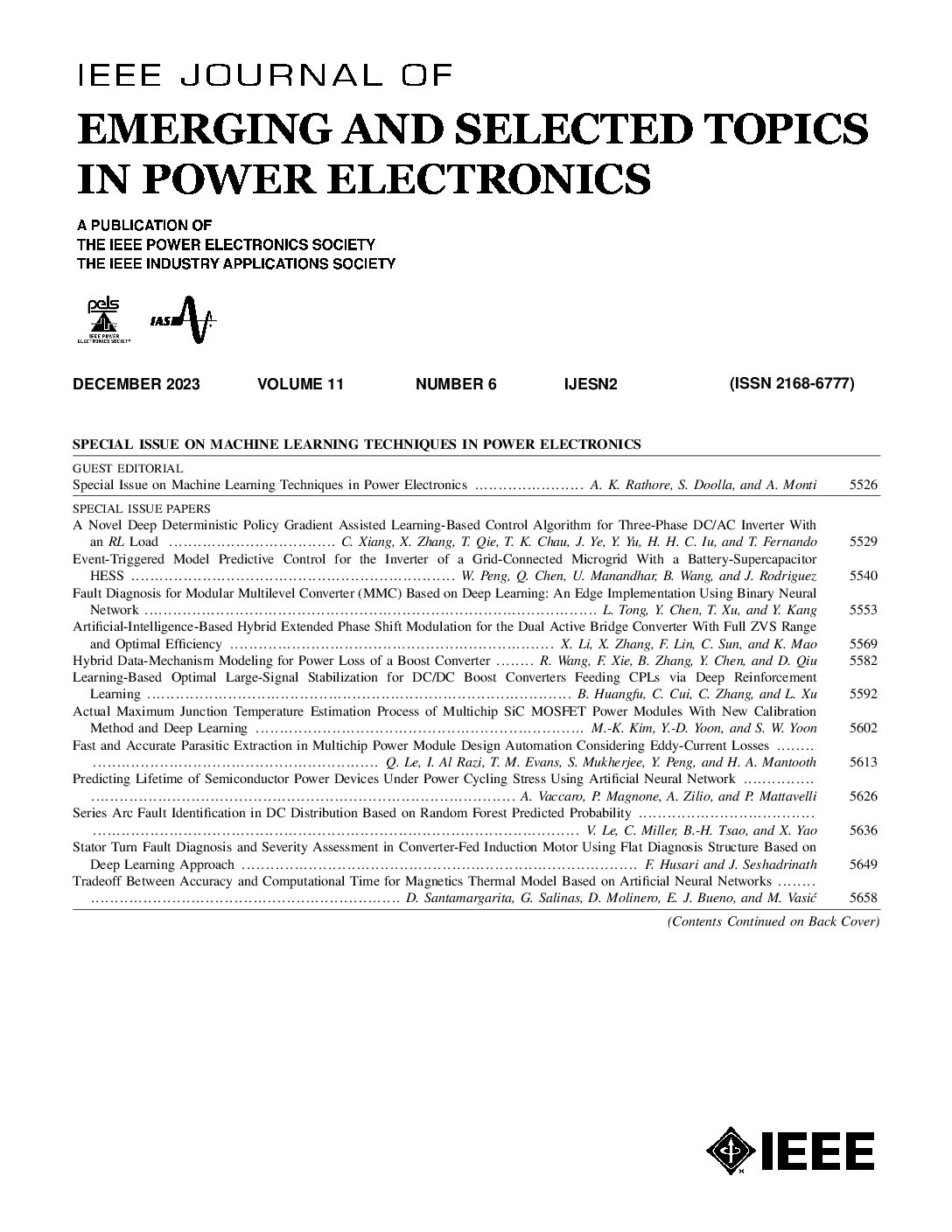有源配电网中集成储能的固态变压器和混合变压器:技术经济比较、调度和控制
IF 4.9
2区 工程技术
Q1 ENGINEERING, ELECTRICAL & ELECTRONIC
IEEE Journal of Emerging and Selected Topics in Power Electronics
Pub Date : 2022-01-18
DOI:10.1109/JESTPE.2022.3144361
引用次数: 34
摘要
固态变压器(SST)和混合变压器(HT)是智能电网中工频变压器(LFT)的有前途的替代品。SST具有中频隔离、电压调节完全可控、无功功率补偿以及电池储能系统(BESS)与多端口配置集成的能力。HT具有用于分数可控性的部分额定转换器,并且可以集成小型BESS。由于太阳能光伏(PV)和电动汽车(EV)普及率的增加,电网边缘电压的快速波动对于机械负载抽头变换器来说很难管理。因此,随着电网中BESS的增加,SST和HT的可控性和存储集成能力备受关注。然而,文献综述表明,现有的SST和HT研究大多在转换器层面,而系统层面的评估很少。评估技术和经济影响对于理解SST和HT的好处和作用至关重要,以指导未来的研究,这是本文首次提出的。中压(MV)SST和MV HT原型的实验结果证实了设备级的可行性,其中首次报道了中压HT原型的电压可控性波形。在改进的IEEE34总线系统上进行了比较仿真。针对SST和HT,提出了一种无网格模型的分散式电网边缘电压控制方法和提前一天的BESS调度方法。仿真表明,与LFT相比,具有集成存储的SST和HT可以容纳更多的光伏,实现调峰,缓解电压波动和反向潮流,并支持能源套利以降低运营成本。此外,在不同的光伏装机容量、HT的部分变流器额定值和BESS容量下,对净现值(NPV)和内部收益率(IRR)进行了综合分析。研究了PV和BESS对未来成本降低的敏感性。尽管NPV和IRR目前为负,但在所研究的用例中,60%的资本成本降低或150%的收入增加将使SST和HT在经济上可行。本文章由计算机程序翻译,如有差异,请以英文原文为准。
Solid-State Transformer and Hybrid Transformer With Integrated Energy Storage in Active Distribution Grids: Technical and Economic Comparison, Dispatch, and Control
Solid-state transformer (SST) and hybrid transformer (HT) are promising alternatives to the line-frequency transformer (LFT) in smart grids. The SST features medium-frequency isolation, full controllability for voltage regulation, reactive power compensation, and the capability of battery energy storage system (BESS) integration with multiport configuration. The HT has a partially rated converter for fractional controllability and can integrate a small BESS. Fast grid-edge voltage fluctuations from increased solar photovoltaic (PV) and electric vehicle (EV) penetration are difficult to manage for mechanical load tap changers. Hence, along with the trend toward more BESS in the grid, the controllability and the storage-integration capability of the SST and HT are of strong interest. However, a review of literature shows existing SST and HT research is mostly at converter level, while system-level assessments are scarce. Assessing technical and economic impacts is critical to understanding the benefits and role of the SST and HT to guide future research, which is presented for the first time in this article. Experimental results from medium-voltage (MV) SST and MV HT prototypes are shown to confirm equipment-level feasibility, where the voltage controllability waveforms of an MV HT prototype are reported for the first time. Comparative simulations are performed on a modified IEEE 34-bus system. A grid-model-less decentralized grid-edge voltage control method and a day-ahead BESS dispatch method are proposed for the SST and HT. The simulations show that the SST and HT with integrated storage can host more PV, achieve peak shaving, mitigate voltage fluctuation and reverse power flow, and support energy arbitrage for operational cost reduction, compared to the LFT. Moreover, comprehensive analyses of net present value (NPV) and internal rate of return (IRR) are performed under different installed PV capacities, HT’s partial converter ratings, and BESS capacities. Sensitivities to future cost reductions of the PV and BESS are studied. Although the NPV and IRR are currently negative, 60% capital cost reduction or 150% revenue increase will make the SST and HT economically viable in the use case studied.
求助全文
通过发布文献求助,成功后即可免费获取论文全文。
去求助
来源期刊

IEEE Journal of Emerging and Selected Topics in Power Electronics
ENGINEERING, ELECTRICAL & ELECTRONIC-
CiteScore
12.50
自引率
9.10%
发文量
547
审稿时长
3 months
期刊介绍:
The aim of the journal is to enable the power electronics community to address the emerging and selected topics in power electronics in an agile fashion. It is a forum where multidisciplinary and discriminating technologies and applications are discussed by and for both practitioners and researchers on timely topics in power electronics from components to systems.
 求助内容:
求助内容: 应助结果提醒方式:
应助结果提醒方式:


